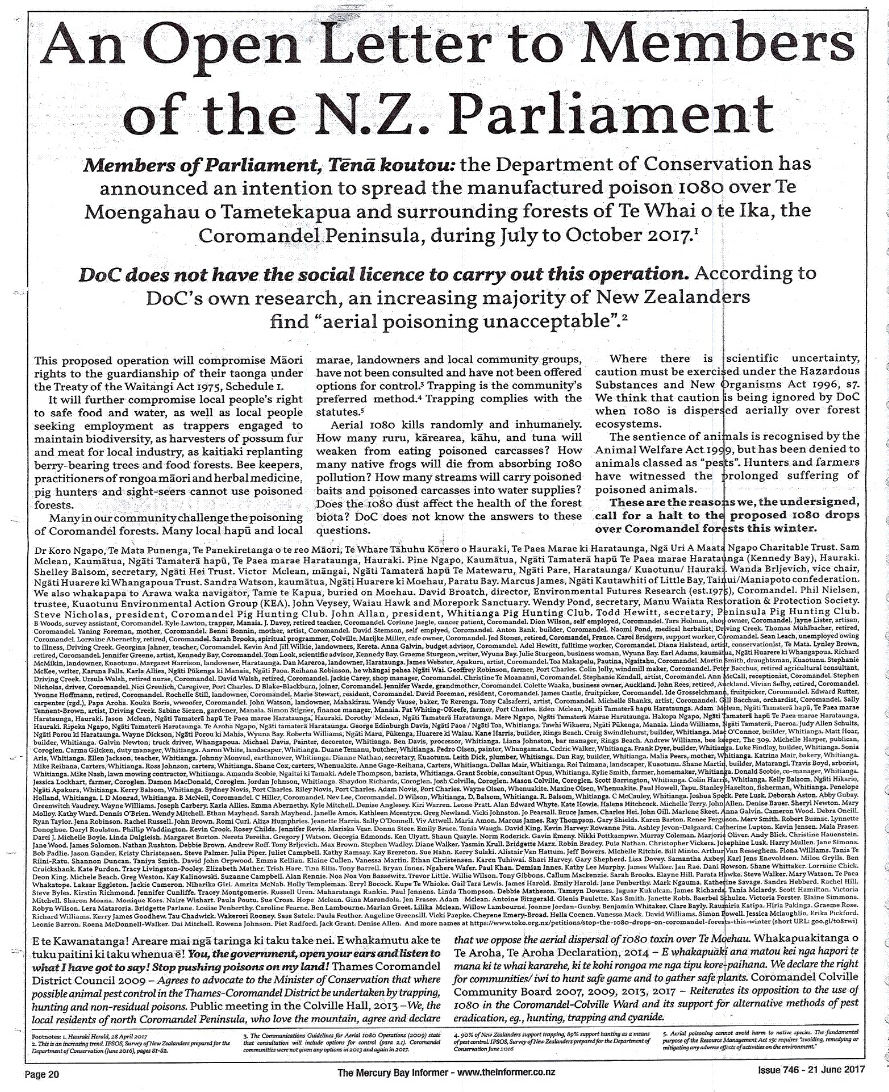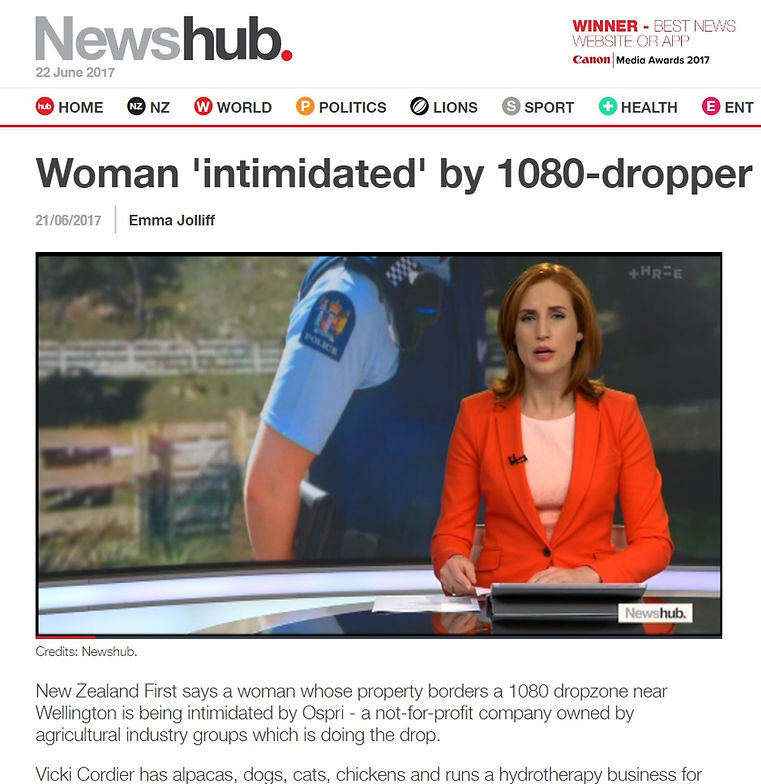Health

Every year around 2 million kilograms of 1080 poison bait is spread across forests and directly into running waterways. Poisoned animal carcasses are left to decompose where they fall - be that on land or in water - despite US warning labels stating animals should be "buried one-half mile from human habitation and waterways." For many years rural communities have raised health concerns with officials and poisoning agencies - most often to fall upon deaf ears.
In 2016 the Waikato District Health Board's Medical Officer of Health responded to questions asked about poisoned animal carcasses decomposing in waterways following aerial operations, poison warning signage, and whether people have a right to know if 1080 poison bait has been dropped into their water supplies. The commentary includes the following statement. "I do understand your belief that people have the right to know that 1080 may have been dropped into waterways, regardless of whether there is a risk to their health or not. In fact, including your proposed wording on notifications could cause unnecessary anxiety to people."
In the email below, the Department of Conservation responds to concerns raised about dozens of Coromandel Peninsula residents drawing water without being informed that the Department of Conservation had dropped 1080 poison bait directly into that water on the same day.
The Department stated that "It was not a requirement from the Waikato District Health Board for us to walk all streams to find unregistered water intakes to undertake mitigation as part of the Southern Coromandel pest control operation."
Note - Under Section 14 (3b) of the Resource Management Act, households are permitted to draw water from streams for their use, and to water their stock - without requiring a consent or to be registered with the Department of Conservation.
There was only one registered intake in a town where dozens of families were legally drawing water.

Click the video below to view the Coromandel 1080 poison operation in which many locals were drawing water without being made aware that 1080 poison bait was dropped directly into it.
Condition 25 of the Health Board document below states that people that draw water from within 3 kilometres of an operational area are entitled to alternative water - if they request it. However, the document is not publicly available, so households that qualify for alternative water are not aware they have the right to request it. Only properties immediately adjacent to the poison operational boundaries are informed of exactly when the poison drops take place. People living further downstream are less notified and often are unaware the operations are taking place.

In 2016 Waikato Regional Council voted to have the words. "Poison baits or carcasses may be present in waterways" added to their poison warning signs to better inform landowners, trampers and forest park users about contamination risks.

In 2008 the Ministry of Health stated: "Studies show that 1080 can cause foetal skeletal malformation, cardiomyopathy/damage to the heart muscle, and testicular effects/reduction in sperm count in animals. To date, there are no known epidemiological studies that have been carried out in relation to 1080 and potential adverse health effects on humans".

The US EPA is reviewing its requirements for releasing chemicals into the environment and any associated risks. This new law is to ensure risks are appropriately assessed, and the EPA states.
"One of the key features of the new law is the requirement that EPA now systematically prioritize and assess existing chemicals, and manage identified risks. Through a combination of new authorities, a risk-based safety standard, deadlines for action, and minimum throughput requirements, TSCA effectively creates a “pipeline” by which EPA will conduct existing chemicals review and management. This new pipeline—from prioritization to risk evaluation to risk management (when warranted)—is intended to drive steady forward progress on the backlog of existing chemical substances left largely unaddressed by the original law. Risk evaluation is the second step of this process, after prioritization, which is being addressed in a separate rulemaking." The new rule will require low-dose, chronic research to be provided as part of the risk assessment for chemicals released into the environment.
Historically, the New Zealand EPA has been less cautious and often lags behind the rest of the world when restricting dangerous chemicals. In 2017 The Ministry of Health was asked if there has been any epidemiological (low-dose - chronic) research undertaken since releasing its statement in 2008. The Ministry of Health's response is presented here.

The Ministry for Primary Industries was recently asked if bottled water was required to be tested for chemicals and bacteria. In its response, it states that businesses are required to meet E Coli thresholds but no mention is made of a requirement to test for chemicals or pesticides - or to parts per trillion.
In the video clip below, Dr Peter Scanlon and Dr Sean Weaver explain the risks associated with low-dose exposure to 1080 poison, and the poor quality of the research used by the poisoning agencies to justify its use.
It is common for land owners in New Zealand to be pressured into accepting the poisoning agencies operational procedures - to aerially spread 1080 poison bait close to their homes, and directly into their water supplies. In most cases, down-stream landowners aren't aware that poison baits are dropped directly into their water supplies, or that poisoned animal carcasses may be present for many months following the aerial application of bait.
The police are employed by the poisoning agencies to ensure the poison drops take place, and to restrain any objection by community members.




Here is a recent example of a community speaking out against a pending 2017 aerial poison drop printed in local media.

Click the tab below to watch the international award-winning documentary Poisoning Paradise, which fully explains 1080 poison use in New Zealand, and answers important questions. Scientists, doctors, teachers, farmers and community groups give their testimonies, interwoven with footage from poison drop zones around New Zealand. Click here to help out.



